
| principles of systematics and nomenclature | general system and phylogeny of insects | systematics of Ephemeroptera |
METHODS OF ASSOCIATING LARVAE AND ADULTS OF MAYFLIES
text from the book by Kluge 2004, with additions and corrections
Mayfly systematics is based on a combination of larval, subimaginal and imaginal characters; however, larvae and winged stages (subimago and imago) are so different, that their association represents a special problem. In literature one can find many mistakes, when such association was made wrongly, so that larvae and imagines of different species were regarded as belonging to the same species, and vice versa, that larvae of adults of the same species were described as different species. Such confusions were made not only on the species level, but on the level of supra-species taxa (genera and families) as well.
Some features of winged stages can be found in the larval stage; this helps to associate them. As in other Pterygota, wing venation is the same in larval protoptera and adult wing (Fig.37:A; 75:A). In the larval protopteron venation represents a system of internal hypodermal channels, which can be seen on translucent slide as light lines. For this purpose it is necessary to take such larva, which is not preparing to molt to next instar or to subimago, in other case wing hypoderm with its channels is crumpled under the larval cuticle.
Mature larvae, which are preparing to molt to subimago, can be used to extract and examine subimaginal features – thorax sclerotization (Fig.102:A–B), caudalii, sometimes genitalia (Fig.84:B–C) and others. Subimaginal wings extracted from mature larva, can be spread after treating by alkali. Structure of subimaginal tarsus with claws can be studied on translucent slide of total larval leg in Canadian balsam; in shortly-molting mayflies the same slide allows to study structure of imaginal tarsus and imaginal claws as well (Fig.98:A–B).
Examination of mature larva allows to study only selected adult characters, but not all which are necessary; particularly, in many mayfly species crumpled subimaginal genitalia inside mature larvae differ from imaginal genitalia so greatly, that their comparison does not allow to associate larvae and adults.
Rearing
In most cases exact association of larvae and imagines can be made by rearing only. Aim of rearing is to get such specimens, each of which has: (1) exuviae of mature larva of last instar, (2) exuviae of subimago, (3) imago. In order to do this, it is necessary to collect mature larvae, put them in a cage with water, wait until larva molts to subimago, then move its larval exuviae in alcohol and put subimago in another cage without water, than wait until subimago molts to imago and put imago and its subimaginal exuviae in alcohol together with the larval exuviae. Here are given suggestions how to do it successfully.
Rearing subimago from larva in stagnant water. Some larval mayflies, especially those which normally inhabit stagnant waters, can be kept in a simple containers until molting to subimago. For individual rearing of small mayflies, plastic glasses are most convenient: GLASSES
Rearing subimago from larva in running water. Larvae normally inhabiting running waters, especially mountain streams, can not live in stagnant water for a long time. For all species it is best to use special cages made of net and placed into natural running water (not obligatory to the same river where these larvae inhabit).
The author uses cages of original construction, which can be folded and packed compactly when traveling, and can be used in all kinds of running waters, including mountain streams and greatest rivers, independently of weather and water level. Two kinds of cages are shown here: Fig.1: A–B and C–D.
The third kind of
cage is made of plastic sieve with walls made of textile. CAGE
MADE OF SIEVE
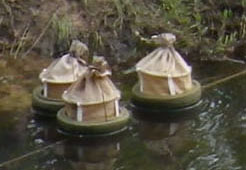
If there is no necessity to pack cages compactly for travel, the cage can have simpler construction.
In all cases the cage for rearing subimagines from larvae must have the following details: It is supplied with floats in such a manner that when floating, a half of the cage is located in the water, and a half above the water, to allow subimagines escape from the water. The cage must be not large, about 12 cm with: if it is larger, it is difficult to find larval exuviae of small species, and if it is smaller, it is difficult to take out emerged subimagines. The whole bottom must be made of fine net (cell 0.4 mm): the dust brought by the water current through the walls must fall down thorough the bottom not accumulating on it. Inside the cage, there must be no places where larvae or their exuviae can be hidden; the framework and sutures must be outside, but not inside. No any objects (stones, sand, leaves, sticks, etc.) should be putted into the cage; the net is a comfortable substrate for mayfly larvae, and water current brings enough food though the net for that larvae, which are not mature enough to stop feeding. Upper part of the cage (located above the water) is made of textile in a form of tube, which has the same width as the part made of net. This allows to open and close the the cage wider or narrower depending on behavior of the emerged subimagines, not allowing them to fly away. Textile is a comfortable substrate for subimagines. When closed, the textile part should have the form of a high roof to give more space for subimagines, and to protect them from rain. The cage floating in running water should be fixed by a cord to something on the bank (tree, stone or something other).
It is preferable to check cages often, not less than three times a day, in extreme cases not less that once a day: if larval exuviae stay in water longer than one day, they are destroyed. In tropical climate, most mayflies molt from larva to subimago in evening, so caged should be especially often checked between 6 p.m. and 8 p.m., or at least at 8 p.m., using headlamp.
Emerged subimagines should be removed from this cage and placed in the cage fore rearing imagines from subimagines (see below). Just after this, take the larval molting skin (exuviae) out of the cage and put it in alcohol, in a temporary tube supplied with the same number as the number in the cage with subimago:
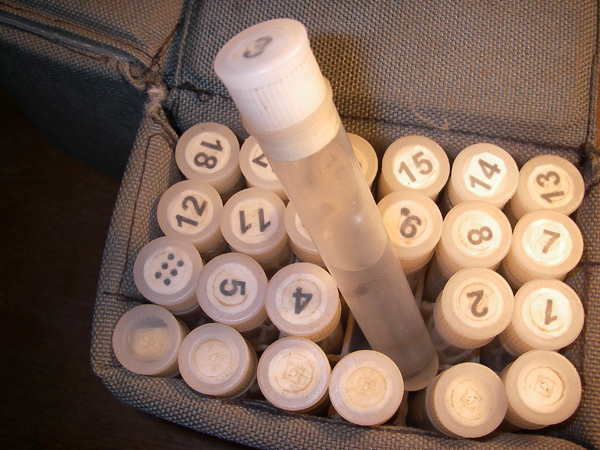 |
| Temporary tubes with alcohol for larval exuviae |
Rearing imago from subimago. Subimago should be kept in a special dry cage until it molts to imago. If retain subimago in the same cage where it was reared from larva, it can fall in the water and die. If remain larval exuviae floating in the water until subimago molts to imago, the larval exuviae rots and falls apart.
The best cage for rearing imago from subimago, is a glass tube about 10 cm length and about 2.5–3 cm in diameter, closed by cotton-wool. Inside the tube it is necessary to put a piece of paper, which is somewhat shorter than the tube and somewhat wider than its diameter; this paper must be immovably pressed to the wall of tube. This paper has three important functions at once: (1) a comfortable substrate for subimago, that makes it to sit quietly and not to spend energy for flying; (2) absorption water from the glass walls, that is necessary to prevent subimago from sticking to the wall; (3) label, on which a specimen number is written by pencil (the same number as on the tube with alcohol containing larval exuviae of this specimen).
It is necessary to move subimago from the cage with water into the dry cage, not touching it neither by fingers, nor by pincer. If touch its wings, it will be unable to molt! If subimago sits on the wall of the cage with water, you can cover it by the dry cage and shake off into the dry cage. If subimago sits on the water surface, you can place a thin stick in front of the subimago to allow it to crawl on this stick. The dry cage with subimago never should be kept at direct sun light, even for a moment; it must be always in shadow. After placing subimago into the dry cage, close it with cotton wool (as shown on the photo below), and than wet the cotton wool, not allowing the water to penetrate inside: air in the cage should be wet, but the walls should be dry.
In temperate zone most subimagines develop about 24 hours, in tropics – during one night. In some species subimagines are transformed to imagines much quicker, in some species longer, up to three days.
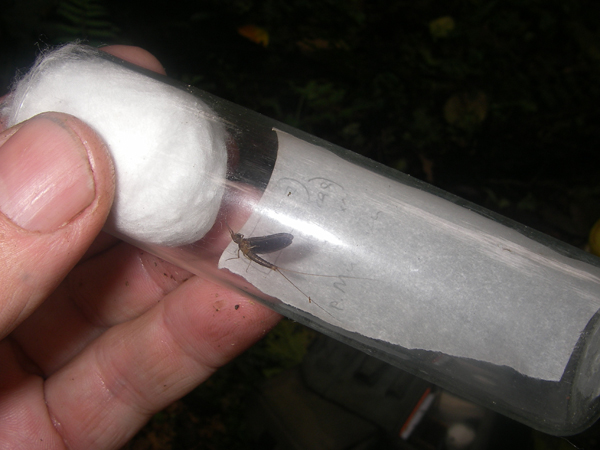 |
| Cage for rearing imago from subimago |
A usual error made when rearing, is confusing of larval exuviae and adults when several larvae are kept together in the same cage. In order to avoid this, it is necessary either to use individual cages for each specimen, or to take out carefully all emerged subimagines and their larval exuviae each time when check the cage. It is important not to confuse exuviae of mature larvae from which subimagines emerged, with exuviae of younger larvae, from which larvae of next instar emerged.
Preservation
All stages of mayflies can be preserved in alcohol of high concentration (75–95%). Since these insects are delicate, they must be kept in small narrow tubes full of alcohol and closed with cotton wool, placed in hermetically closed glass with alcohol: in this case tubes should not contain air bulbs, which could destroy mayflies if shaken. When you take mayflies from a cage, it is convenient to put them temporarily into large tubes (see photo above), and than move to small tubes for permanent preservation. This moving material from a large tube to a small one helps to keep high concentration of alcohol. Each tube contains a label, where are written (1) place of collecting (beginning with country and such toponym which everybody can find on a map, and finishing by name of the river and village, or a distance to nearest village); (2) date (day, month, year); (3) name of the collector. Label can be written either by simple pencil (not color pencil!), or by black Indian ink (not other ink!), or typed on laser printer (not ink printer!). Label is a little wider than diameter of the tube and much shorter than the tube; in this case it can be putted into the tube as in the photos below; at first put the label, and than insects, in order not to press the insect by the label.
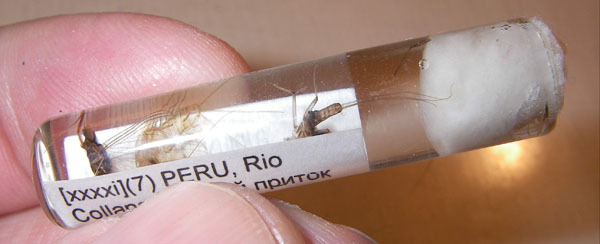
Tube with alcohol containing imago, its larval exuviae and its subimaginal exuviae |
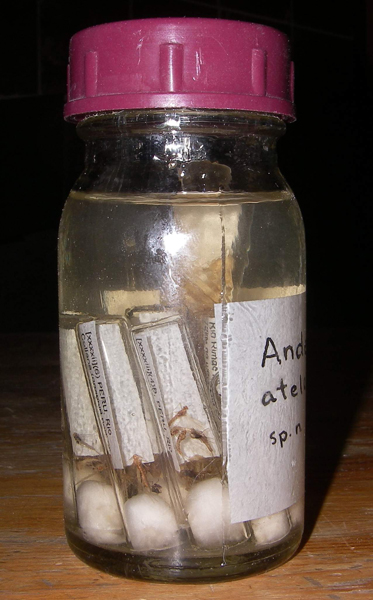 |
For examination, it is useful to make slides of all parts of mayflies and their exuviae. Separated parts can be mounted in Canadian balsam; this allows to study not only cuticle, but muscles as well. Delicate translucent cuticular parts,
e.g.
colorless wings and tergalii, can be mounted in dry condition to see better their details (in this case cover glass can be glued to the mount by Canadian balsam by sides).
 |
| Slide of larval, subimaginal and imaginal parts of one and the same individual |